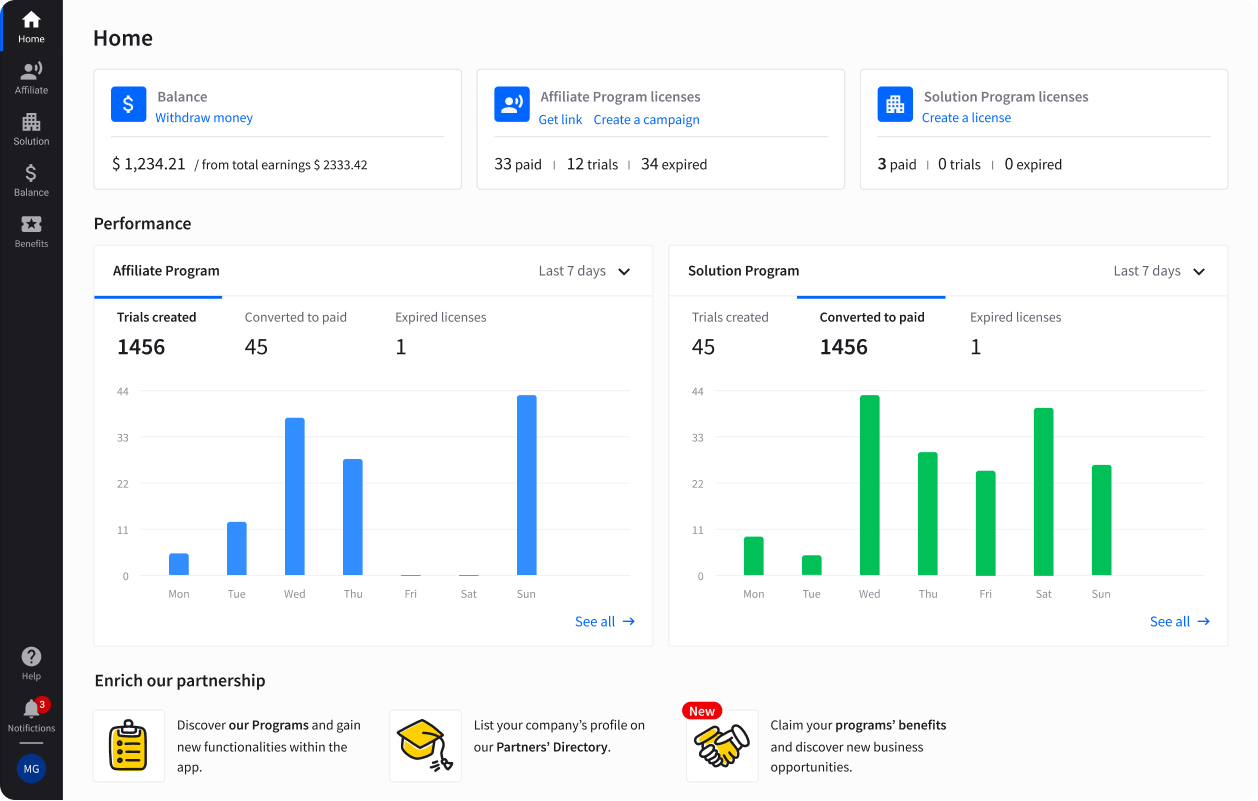Showing top 0 results 0 results found
Showing top 0 results 0 results found
Conversion Rate Optimization Secrets Every Affiliate Marketer Should Know

What you'll learn from this article:
- Understanding Conversion Rate Optimization (CRO) in Affiliate Marketing
- CRO metrics for affiliate marketers
- Key on-page CRO strategies
- Importance of A/B testing
- Common CRO mistakes
Key findings
What is Conversion Rate Optimization (CRO)?
CRO is the process of enhancing your website and content to increase the percentage of visitors who complete desired actions, such as purchases or sign-ups. It's a critical component for affiliate marketers aiming to maximize their revenue.
What is A/B testing?
This involves comparing two versions of a webpage or element to determine which performs better. Regular A/B testing helps in making data-driven decisions to improve conversion rates.

Ever feel like you’re driving tons of traffic to your affiliate offers, only to see a measly 1–2% of visitors actually buy? Industry data indicate that the average affiliate conversion rate hovers around 1-3%, while the top 10% of earners achieve rates of 5–10%.
That gap isn’t just about luck. It’s about how you optimize every click, every call-to-action, and every piece of content to turn casual surfers into happy buyers.
Here, we’ll dig into the biggest CRO mistakes affiliate marketers make (confusing CTAs and slow mobile pages), and stir up why those slip-ups are quietly bleeding your bottom line.
Then, arm yourself with step-by-step, data-driven tactics that you can implement today to start boosting your revenue—no extra traffic required. Let’s dive in!
Defining CRO in the context of affiliate marketing
Conversion rate optimization (CRO) isn’t just swapping button colors on a product page. For affiliates, CRO means fine-tuning every touchpoint you control, before a visitor even clicks your link.
- Beyond general ecommerce: You don’t have complete control of checkout pages or pricing, so your optimization happens upstream, in your content, email pitch, and pre-sell hooks.
- Unique affiliate challenges: You’re juggling multiple merchants, link types, and commission structures. Plus, you can’t tweak a merchant’s landing page if it loads slowly or misses trust signals.
- Pre-click funnel focus: Think headlines, story arcs, social proof, and email sequences. Optimize those to warm readers up so they’re primed to click and buy, before they ever hit the merchant site.
Why is conversion rate optimization important for affiliate success
Chasing more traffic is a never-ending hamster wheel. Mastering CRO lets you squeeze more revenue out of the audience you already have.
- Increase revenue without more traffic: Even a 0.5% lift in conversions can translate to thousands of dollars extra each month.
- Maximize visitor value: Every blog reader, email subscriber, or social follower becomes more profitable.
- Sustainable, long-term growth: CRO improvements compound over time, unlike ad spikes that disappear when the budget runs dry.
- Competitive edge: When you convert better than other affiliates in your niche, you climb higher in search, win better bonuses, and attract premium partnerships.
The bottom line? Conversion optimization isn’t optional for affiliate marketers; it’s the secret sauce that turns clicks into cash.

Key CRO metrics for affiliate marketers
If you are wondering which metric to tweak first, this table will help you identify the key metrics that move the needle in an affiliate funnel.
| Metric | Definition | Why it matters for affiliates | Example calculation / Tracking method |
| Click-through rate (CTR) | % of visitors who click on your affiliate link | Directly affects how many potential buyers you send to the merchant | (Clicks/ Impressions)*100. Track with Google Analytics event tags or your dashboard |
| Conversion rate (CR) | % of visitors who complete the desired action (like purchase) | The ultimate yardstick for affiliate success | (Conversions/ Visits)*100. Set up GA Goals or pull from affiliate network reports |
| Earnings per click (EPC) | Average earnings generated each time an affiliate link is clicked | Lets you compare offer profitability at a glance | Total Affiliate Earnings/ Total Clicks. Check your affiliate platform dashboard |
| Revenue per visitor (RPV) | Average revenue earned for each visitor to your site/page | Shows how well you monetize overall traffic, not just clicks | Total Revenue/ Total Visitors. Combine GA revenue tracking with affiliate data |
| Bounce rate | % of visitors who leave after viewing only one page | High bounce on review or comparison pages means your content isnât hooking readers | (Single-page Sessions/ Total Sessions)*100. View in Google Analytics |
| Time on page | Average time visitors spend on a specific page | Longer reads often signal engagement, and more opportunity to click your links | GA Behavior -> Site Content -> All Pages |
| Exit rate | % of visits that end on a specific page | Pinpoints pages where readers drop out before clicking through | (Page Exits/ Pageviews)*100. Check in GA's Exit Pages report |
Think of these metrics as your CRO dashboard lights. If your CTR is flatlining, it’s time to sharpen your headlines or CTA. If the bounce rate is sky-high on your comparison table, maybe the intro isn’t setting clear expectations.
And don’t sleep on EPC, it’ll tell you at a glance which offers deserve more real estate on your site. By tracking and optimizing each of these, you’ll systematically plug revenue leaks and make every visitor count.
Ready to dive deeper? Next up: the hands-on tactics that move these numbers north.
Understanding your audience and their intent
As an affiliate marketer, you’re essentially staking your reputation on products you recommend. If you truly understand who you’re talking to and what keeps them up at night, you’ll not only build credibility but also significantly increase your conversion rates.
Before you tweak headlines or swap button colors, you need to know who you’re optimizing for. Imagine running a promotion for a high-end DSLR to readers who’re only snapping photos on their phones.
Your messaging will miss the mark. Nail down your website visitors' real-world needs, and every optimization you make will hit the bull’s-eye.
Beyond demographics: Dive into psychographics
- Goals and motivations: What outcome are they chasing? More sales? Faster workflows?
- Pain points: What frustrations keep them from pulling the trigger?
- Decision drivers: Are they price-sensitive or chasing premium features?
- Trust triggers: Do they need social proof, case studies, or expert quotes?
Getting granular with these psychographic factors means you can tailor your content to feel like you’re reading their minds and improve your average conversion rate.
Identifying user intent in affiliate marketing
Every time someone lands on your page, they bring one of four intent “hats.” Your job? Match your content to their hat.
- TransactionalReady to buy.
- Expect direct “Buy Now” CTAs and transparent pricing.
- NavigationalLooking for a specific brand or site.
- Often, just need a streamlined link or site structure.
- InformationalResearching features or “how it works.”
- They want guides, tutorials, and deep dives.
- Commercial InvestigationComparing options.
- They crave side-by-side tables, pros & cons, and recommendation logic.
Mapping user intent to content strategy
- Tailor your content to match their intent stage, reviews for buyers, how-tos for learners, comparisons for comparers.
- Answer questions up front: Anticipate objections and sprinkle the answers throughout your copy so there’s no doubt after they click.
- Expert Tip: Before each post launches, ask yourself: What does someone who lands here already know, and what do they still need to know?
| Intent Type | Example Search Query | Affiliate Content Focus |
|---|---|---|
| Transactional | "buy [product name] online" | Direct product reviews, coupon pages, "best price" roundups |
| Informational | "How does [product] work?" | How-to guides, educational articles, problem/solution deep dives |
| Commercial Investigation | "[product A] vs [product B]" | Side-by-side comparisons, pros & cons lists, buyer's guides |
| Navigational | "[brand name] official site" | Brand overview or review (less about CRO tweaks, more about clear links) |
By pinpointing intent and aligning your content strategy, you’re delivering exactly what each visitor needs at just the right moment.

On-Page CRO strategies
When you’re an affiliate marketer, the quickest wins usually happen on your own turf: your website. On-page conversion optimization is all about tweaking the bits and pieces visitors interact with on a web page before they ever click your affiliate links.
Since you can’t control a merchant’s checkout page or shipping fees, your superpower is shaping everything upstream: headlines, copy, visuals, CTAs, layout, and even technical details like page speed.
Here are some on-page tactics that will help you turn more browsers into buyers.
1. Optimizing headlines and introductions
Your headline and intro are your shop window. They’ve got to grab attention and set the right expectations. If they miss, nobody sticks around.
- Grabbing attention immediately: Lead with a hook, ask a question, share a jaw-dropping stat, or paint a vivid picture of the result your reader wants.
- Setting clear expectations: Promise what the article delivers. If you say “3 easy steps to…” make sure you provide exactly three easy steps.
- Matching search intent: If someone searched “best travel backpacks under $100,” your headline should reflect that phrasing to signal relevance.
- Power words and benefit-driven language: Words like “secret,” “proven,” “unlock,” and “instant” punch up emotional impact. Combine them with clear benefits (“unlock instant comfort on long hikes”) to make the value obvious.
2. High-converting affiliate copywriting
Once you’ve hooked your reader, your copy has to do the heavy lifting: build trust, address objections, and make the next step irresistible.
- Focus on benefits, not just features: “This blender has a 1200W motor” is fine, but “Crushes ice in seconds so you get velvety smoothies every morning” sells the lifestyle.
- Build trust and credibility: Share personal anecdotes (“I’ve tested this camera in rain and shine”), cite data (“98% of users report faster charge times”), and be transparent about both pros and cons.
- Address pain points and aspirations: What keeps your audience up at night? Highlight that (“Tired of your phone dying mid-zoom?”) and show how your recommendation solves it.
- Use persuasive storytelling: Paint a before-and-after scenario. “Last year, I wasted hours manually editing photos. Now, with this plugin, I finish in minutes.”
- Never rush readers off to the merchant's eCommerce website. Spend a few lines reinforcing why they can trust you, then drop that affiliate link.
3. Visuals: images, videos, and graphics
Words are great, but people crave visuals. They break up text, illustrate your points, and keep readers engaged.
- Break up long paragraphs: Use images or graphics every 300–400 words to give eyes a rest and keep the page scannable.
- High-quality and relevant: Stock shots of happy users? Meh. Original photos of you using the product, annotated screenshots, or custom diagrams pack more punch.
- Optimize file sizes for speed: Large images kill load times and speed on mobile devices. Compress them with tools like TinyPNG or ShortPixel to keep your page snappy.
- Integrate helpful videos: A 60-second demo or a quick unboxing clip can boost engagement and conversions, especially when embedded near your CTA.
- Visual Suggestion: Consider creating an infographic that maps out the affiliate CRO funnel: from landing page to link click to purchase to boost conversions.
4. Call-to-action (CTA) optimization
CTAs are the gateway to your affiliate earnings. Minor tweaks here can yield surprisingly big results.
- Clear, concise, compelling: “Download Your Free Checklist” beats “Click Here.” Spell out the value and the action.
- Test different CTA text: “Learn More” vs “Get 10% Off Now” vs “Claim Your Spot.” Run simple A/B tests to see what resonates.
- Experiment with button color, size, and placement: A larger, contrasting button above the fold might outperform a subtle text link at the bottom.
- Use urgency or scarcity (ethically): “Only 5 spots left” or “Deal ends midnight” spurs desired action, but don’t bluff.
- Expert Tip: Start here. Changing one word or relocating your button can increase clicks by 10–20%.
- Step-by-step A/B testing guide:Pick one element: Button text, color, or placement.
- Create two versions: Variant A (current) and Variant B (your tweak).
- Split testing your traffic evenly between A and B using a plugin like Nelio A/B Testing.
- Run the test until you hit statistical significance (often 1–2 weeks).
- Implement the winner and iterate on the next element.
4. Page layout and user flow
Your layout should feel like a guided tour to increase conversions: no dead ends, no confusing detours.
- Logical structure: Break content into clear sections with descriptive subheadings so readers always know where they are.
- White space: Don’t jam every inch with text and images. Breathing room makes CTAs pop and improves readability.
- Above the fold: Place your primary CTA or key benefit statement where it’s visible without scrolling.
- Minimize distractions: Sidebar ads, popups on popups, those can kill the conversion funnel. Use only what’s essential to guide the reader forward.
- Expert Tip: Use internal links to shepherd visitors from blog posts to high-converting landing pages or product reviews. A “Related Articles” widget at the bottom can boost session depth and click opportunities.
5. Technical on-page factors
The finest copy and visuals won’t matter if your page takes forever to load or looks wonky on mobile.
- Site speed: Every extra second of load time can negatively impact a website's conversion rate. Compress files, leverage a content delivery network (CDN), and minimize script loading.
- Mobile responsiveness: More than half of affiliate traffic comes from smartphones. Test your pages on different devices and make buttons thumb-friendly.
- Clarity and readability: Use a legible font size (16px+), comfortable line spacing, and clear contrast to improve user behavior. If readers squint, they’ll bounce.
- Prioritize mobile optimization first. A streamlined, fast-loading mobile page often outperforms a bloated desktop design.
These on-page search engine optimization and digital marketing strategies give you direct control over the factors that truly drive results for affiliate marketers. Tackle headlines, copy, visuals, CTAs, layout, and tech one at a time. Test as you go, iterate fast, and watch your conversion rates climb.
Specific on-page elements and tactics
| Element | CRO tactic | Why it works |
|---|---|---|
| Headline | A/B test benefit-driven vs curiosity hooks | Grabs attention, sets clear expectations |
| Introduction | Apply PAS, state your value proposition up front | Hooks readers by showing you understand their pain points |
| Affiliate links | Test text links vs. buttons vs in-content images | Different formats catch different clickers |
| Images / Video | Use high-quality media, lazy-load/ compress | Visual proof of value. Keeps pages fast |
| Page layout | Clear headings, bullets, ample white space | Makes content scannable and guides the eye to your CTAs |
| Site speed | Compress assets, leverage browser caching | Fast pages lower bounce and boost search rankings |
| Mobile design | Thumb-friendly CTAs, responsive layouts | Ensures smooth clicks on the device most readers use |
| Internal linking | Contextual links to reviews or comparisons | Guides visitors deeper toward high-converting pages |
| Social proof | Embed real customer testimonials and ratings | Builds instant trust. Proof that real people love it |
| Trust badges | Add security seals or money-back icons | Eases anxiety around clicking off your site |
Pick two or three elements you’re not already testing. Apply these examples this week, track the lift, and watch your affiliate profits climb!
Pre-sell and landing page optimization
As an affiliate marketer, your biggest lever isn’t tweaking checkout buttons you don’t own. It’s mastering the art of pre-selling. Think of pre-sell content as your personal sales conversation: it builds trust, educates, and filters out tire-kickers before they ever click your link.
Nail this step, and you send only qualified, eager buyers on to the merchant, boosting both your site's conversion rate and your EPC.
The importance of pre-sell content
Before a visitor lands on a merchant’s page, they need to:
- Build rapport and trust: Readers are more likely to buy from people they like and trust. Share authentic anecdotes and show you’ve done the homework.
- Educate about the product/service: Highlight key benefits and use cases so visitors know exactly how this product solves their problem.
- Overcome initial objections: Address FAQs upfront, price concerns, compatibility questions, or the question, “Is it worth it?”
- Filter unqualified traffic: Make it clear who the product is for (and who it isn’t). If your pre-sell is specific, “perfect for budget-conscious travelers,” you’ll attract the right buyers.
Optimizing different pre-sell formats
Each format has its CRO-winning recipe. Here’s how to structure yours:
1. Product Reviews
- Structure: Begin with your own experience, then dive into features, followed by a clear list of pros and cons.
- Depth: Go beyond specs, show real-world results (“I tried these running shoes on a 10K and shaved two minutes off my time”).
- CTAs: Place a “Get Yours Now” button after your personal story and again after the pros and cons.
2. Comparison guides
- Criteria: Define the factors that matter (price, durability, ease of use).
- Side-by-side tables: Let readers scan differences at a glance.
- Highlight differences: Use icons or colored text to draw attention to the winner in each row.
- Strong summary: Conclude with a “Best For…” callout so skimmers know precisely which model is best suited for them.
3. “Best of” lists
- Ranking factors: Be transparent about how you chose and ranked each item.
- Concise descriptions: Using one benefit-driven sentence per product keeps the content scannable.
- Snippet potential: Use numbered lists and short paragraphs to optimize for featured snippets.
4. Tutorials/How-tos
- Natural integration: Introduce your affiliate product as the hero solution within each step.
- Problem/Solution flow: “Step 1: Identify the issue. Step 2: Install X plugin (click here). Step 3: Enjoy faster load times.”
- Visual aids: Include annotated screenshots or GIFs to show installation or usage.
5. Dedicated landing pages
- Single focus: Strip away the sidebar, related posts, and other distractions.
- Persuasive copy: Lead with a bold promise, back it up with social proof, and end on a clear CTA.
- Minimal navigation: The only logical escape is to click your button.
Unique content element: Create a “Before and After” mini case study. Show a screenshot of an old review page with a low CTR next to a redesigned page with a bright button and testimonial, then share the percentage lift you hypothetically achieved.
Tips to improve pre-sell content conversion
- Benefit-driven focus: Lead every section with “what’s in it for them.”
- Storytelling: Use a mini narrative arc, problem, struggle, and breakthrough, to keep readers emotionally invested.
- Social proof: Drop real quotes or user stats (“4.8 out of 5 stars from 3,000+ users”) near your affiliate link.
- Natural transitions: Phrase your link as part of the solution, such as “To achieve this exact result, click here.”
- Link format experiments: Rotate text links, buttons, and images to see which format your audience clicks most.
Optimizing pre-sell formats
| Pre-sell format | CRO tactics | Best use cases |
|---|---|---|
| Product review | - Clear H2 headings ("My Experience," "Pros and Cons") - Personal anecdotes with data ("saved me 20% time") - Prominent, repeated CTAs | High-ticket or complex products where authority sells. |
| Comparison guide | - Side-by-side table with icons highlighting the winner - Short pros/cons bullets under each column - Top-line recommendation box | When readers are in the decision stage, they are choosing between similar options. |
| âBest ofâ list | - Numbered list for snippet optimization - One-liner benefits + image for each item - Clear ranking methodology note | Roundups around a theme (for instance, "Best budget headphones"). |
| Tutorial/How-to | - Step numbers with embedded affiliate links - Before/after visuals or short GIFs - Summary CTA at the end of the steps | Driving traffic from "how to" searches where a tool solves the problem. |
| Landing page | - Hero headline + single CTA - One testimonial near the top - Minimal nav, fast load time | Paid ads, dedicated email traffic, or promo campaigns. |
Mastering pre-sell and landing page optimization strategy means you’re qualifying leads, building trust, and guiding readers gently yet decisively toward the affiliate click. Apply these tactics with real examples, test your variations, and you’ll see those conversion rates and earnings soar.
Tracking, testing, and analytics
When it comes to converting your website visitors, guesswork just won’t cut it. Conversion rate optimization is a scientific process: you form hypotheses, run controlled experiments, measure results, and iterate.
That’s where testing and website analytics come in. They turn opinions into data-backed decisions. Embracing a rigorous, EEAT-driven approach (experience, expertise, authoritativeness, trustworthiness) shows your readers, and the search engines, that you’re committed to verifiable results, not fluff.
By using analytics platforms, you can pinpoint precisely where visitors drop off, which elements spark engagement, and how tweaks translate into real dollars.

Setting up tracking for affiliate conversions
Before you optimize, you need visibility into what’s working. Here’s how to get crystal-clear tracking:
- UTM parameters for link tracking
Tag every affiliate link with UTM source, medium, and campaign. This way, you can see which blog posts, email blasts, or social posts drive the most affiliate clicks in Google Analytics. - Goals and events in GA
Create an Event for “Affiliate Link Click” (via Google Tag Manager) and set it up as a Google Analytics goal. Now you’ll know exactly how many clicks each link generates. - Understand post-click limitations
Once someone clicks through to the merchant site, your tracking often stops, unless the merchant shares post-click data. Factor this into your expectations and focus on optimizing the pre-click funnel. - Use Performance Reports
Dive into Behavior → Events and Acquisition → Campaigns in GA to compare link and page performance side by side. - Track everything meticulously. A single missing UTM tag can skew your insights and lead you astray.
Principles of A/B testing (and beyond)
Testing is non-negotiable if you want to know “what works.” Here’s your testing playbook:
- Test one element at a time
Don’t swap headlines and button colors in the same experiment. Keep it singular so you know which change drove the lift. - Define your hypothesis and metrics
“I believe that changing the CTA from ‘Learn More’ to ‘Get 20% Off’ will increase clicks by at least 10%.” That’s your North Star. - Ensure statistical significance
Run your test long enough (or get enough traffic) so that results aren’t just random noise. Many tools have built-in calculators for this. - Explore multivariate testing (MVT)
Once you’ve mastered A/B, MVT lets you test multiple elements (like headline + image) at once. But it requires more traffic and careful setup. - Always start with the highest-impact element (headline or primary CTA) and test in a distraction-free environment.
Using analytics CRO tools for insights
Raw numbers tell part of the story, but user behavior tools fill in the rest. Here’s how to get the complete picture:
- User flow reports
In GA, the User Flow report shows you common paths and drop-off points. If 60% of visitors leave on your “Review” page, that’s where you double down. - Identify high-performing pages
Look at Pages with the highest goal completion rates and dissect what they’re doing right, structure, copy style, or visual elements. - Segment your data
Compare desktop vs. mobile, organic vs. paid, or new vs. returning visitors. You might discover your mobile CTA needs resizing or your email traffic prefers a different content angle. - Heatmaps and session recordings
Tools like Hotjar or Mouseflow show exactly where users click, how far they scroll, and where they hesitate. This qualitative insight is gold for optimizing layouts and CTAs. - Expert Tip: Watch session recordings of both converting and non-converting visitors. You’ll spot friction points that analytics metrics alone can’t reveal.
- Advanced testing platforms
For sophisticated experiments, like multi-page funnels or complex segmentation, Optimizely and VWO offer enterprise-grade features to accelerate your CRO roadmap.
Essential tools and methods for tracking and testing
| Tool/Method | Purpose | How does it help CRO |
|---|---|---|
| Google analytics | Track website traffic, user behavior, and goal completions | Identifies top-performing pages, user flows, bounce rates, and affiliate click goals |
| UTM parameters | Tag source, medium, and campaign on each link | Measures the performance of individual links and promotional channels |
| Google Tag Manager | Manage analytics tags, pixels, and event tracking | Simplifies the setup of click-event tracking (affiliate clicks, CTA taps) |
| Heatmaps/Session recordings | Visualize clicks, scrolls, and mouse movements | Reveals friction points, ignored CTAs, and content that drives engagement |
| A/B testing platforms | Run controlled experiments on page variations | Quantifies the impact of changes (headlines, CTAs, layouts) on key metrics |
| User Polls/Surveys | Gather direct user feedback from visitors using any web form | Uncovers visitor objections, confusion points, and content gaps |
By setting up airtight tracking, running disciplined tests, and diving deep into analytics, you transform CRO from guesswork into a verifiable, repeatable science. Thus, supercharging your affiliate revenue in the process.
Common CRO mistakes in affiliate marketing
Learning from others’ slip-ups can save you loads of time and money. Here are the key pitfalls affiliate marketers run into (and exactly how to dodge them).
1. Testing too many variables at once
Ever try changing your headline, button color, and intro all in one go? The result is chaos; you’ll never know which tweak moved the needle.
- The solution: Pick one high-impact element (headline, CTA text, or image) per test. Run it until you hit statistical significance, then move on to the next.
2. Not enough traffic for reliable tests
Running A/B tests on low-traffic pages leads to guesswork disguised as data.
- The solution: Use a sample-size calculator to estimate the needed duration and volume. Start testing on your busiest posts first, or group similar pages together to create a larger pool.
3. Ignoring the mobile experience
If your pages load slowly or buttons are too small on phones, mobile visitors will bounce, and your conversion rates will suffer.
- The solution: Adopt a mobile-first mindset. Check your site on different devices, boost button sizes to at least 44×44px, and compress images for faster load times.
4. Focusing only on clicks, not conversions or EPC
A high click-through rate feels good, but if those clicks don’t turn into earnings (EPC), you’re leaving money on the table.
- The solution: Track downstream metrics, such as EPC and actual conversions, wherever possible. If your merchant shares post-click data, integrate that into your analytics.
5. Making assumptions instead of using data
“I feel like red buttons convert better,” but feelings don’t pay the bills.
- The solution: Always back decisions with analytics. Use heatmaps, session recordings, and conversion data to guide you, not gut instinct.
6. Copying competitors blindly
Just because your niche rival’s page converts doesn’t mean the same layout or headline will work for your unique audience.
- The solution: Treat competitor sites as inspiration, not instruction manuals. Replicate ideas one at a time and test them rigorously on your site.
7. Not disclosing affiliate relationships
Hiding your affiliate links can erode trust and even violate regulations.
- The solution: Place a clear disclosure at the top of your post (“This article contains affiliate links; I may earn a commission”). Honesty builds credibility and conversions.
8. Ignoring user intent
If you’re writing a “how-to” article but packing it with hard-sell CTAs, you’ll confuse and lose readers.
- The solution: Match content format to user research intent. Informational queries get educational articles, and transaction-ready visitors get direct product reviews.
Actionable steps for implementing your CRO plan
Ready to launch your CRO plan? Here’s a friendly, step-by-step roadmap tailored for affiliate marketers, complete with practical how-to details and clear goals.
| Step | Action (How to accomplish it) | Goal |
|---|---|---|
| Audit | Utilize Google Analytics and heatmap tools (like Hotjar) to analyze your top-performing affiliate pages. Map user flows, spot where visitors drop off, and note slow-loading or cluttered spots. | Identify friction points and underperforming elements. |
| Prioritize | Score potential tests by Impact vs Effort (use a simple 2x2 matrix or ICE scoring). Pick quick wins, like tweaking the CTA on your highest-traffic review post. | Focus on low-effort, high-impact optimizations first. |
| Set up tracking | Tag every affiliate link with UTM parameters. In Google Tag Manager, create an "Affiliate Click" event and hook it into a GA Goal. Verify in your GA dashboard. | Gain clear visibility into which links and pages drive clicks |
| Formulate hypothesis | Based on your audit, craft a specific hypothesis (like "Changing 'Buy Now' to 'Get 10% Off' will boost clicks by 15%"). Write down your expected uplift and why. | Define measurable expectations to test your assumptions |
| Implement and test | Launch an A/B test on one element (headline, CTA text, image) using a tool like VWO or Optimizely. Split traffic evenly and let it run until results are significant. | Collect reliable data to prove or disprove your hypothesis |
| Analyze results | Check the statistical significance and compare CTR, EPC, and conversion metrics between variants. Segment by device or source to uncover hidden insights. | Understand what worked and why. Inform future test ideas |
| Iterate | Roll out the winning variation across similar pages. Document learnings, adjust your priority list, and plan the next experiment based on fresh data. | Maintain a cycle of continuous improvement and revenue growth. |
Wrapping up
Conversion rate optimization isn’t a one-off sprint. It’s more like tending a garden: you plant the seeds, monitor growth, prune what isn’t working, and celebrate the blooms.
By focusing on your audience’s needs, matching their intent, and optimizing everything you control: your headlines, pre-sell content, CTAs, and technical setup, you’ll squeeze more revenue out of every visitor without chasing endless traffic.
Keep your data-driven mindset sharp: track clicks, run disciplined A/B tests, and learn from both wins and flops. Avoid common pitfalls like guessing instead of testing or ignoring mobile users, and you’ll save time and boost your bottom line.
And suppose you’re looking for a top affiliate program to implement these CRO tactics. In that case, the LiveChat affiliate program offers competitive commissions, reliable tracking, and top-notch support, perfect for affiliates ready to optimize their way to higher earnings.
Happy optimizing!



